Spring Security Hello World Annotation Example

In preview post, we are using XML files to configure the Spring Security in a Spring MVC environment. In this tutorial, we are going to show you how to convert the previous XML-base Spring Security project into a pure Spring annotation project.
Technologies used :
Spring 3.2.8.RELEASE
Spring Security 3.2.3.RELEASE
Eclipse 4.2
JDK 1.6
Maven 3
Tomcat 7 (Servlet 3.x)
Few Notes
This tutorial is using WebApplicationInitializer to load the Spring Context Loader automatically, which is supported in Servlet 3.x container only, for example, Tomcat 7 and Jetty 8.
Since we are using WebApplicationInitializer, the web.xml file is NOT required.
Spring Security annotations are supported in older Servlet 2.x container, for example, Tomcat 6. If you use the classic XML file to load the Spring context, this tutorial is still able to deploy on Servlet 2.x container, for example, Tomcat 6
1. Project Demo
See how it works.
2. Directory Structure
Review the final directory structure of this tutorial.
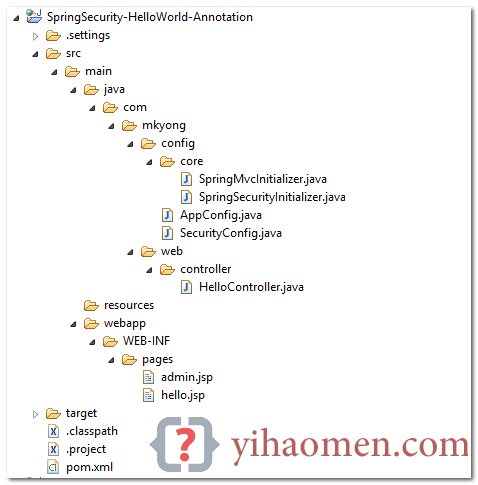
3. Spring Security Dependencies
To use Spring security, you need spring-security-web and spring-security-config.
pom.xml
<properties>
<jdk.version>1.6</jdk.version>
<spring.version>3.2.8.RELEASE</spring.version>
<spring.security.version>3.2.3.RELEASE</spring.security.version>
<jstl.version>1.2</jstl.version>
</properties>
<dependencies>
<!-- Spring 3 dependencies -->
<dependency>
<groupId>org.springframework</groupId>
<artifactId>spring-core</artifactId>
<version>${spring.version}</version>
</dependency>
<dependency>
<groupId>org.springframework</groupId>
<artifactId>spring-web</artifactId>
<version>${spring.version}</version>
</dependency>
<dependency>
<groupId>org.springframework</groupId>
<artifactId>spring-webmvc</artifactId>
<version>${spring.version}</version>
</dependency>
<!-- Spring Security -->
<dependency>
<groupId>org.springframework.security</groupId>
<artifactId>spring-security-web</artifactId>
<version>${spring.security.version}</version>
</dependency>
<dependency>
<groupId>org.springframework.security</groupId>
<artifactId>spring-security-config</artifactId>
<version>${spring.security.version}</version>
</dependency>
<!-- jstl for jsp page -->
<dependency>
<groupId>jstl</groupId>
<artifactId>jstl</artifactId>
<version>${jstl.version}</version>
</dependency>
</dependencies>4. Spring MVC Web Application
A simple controller :
If URL = /welcome or / , return hello page.
If URL = /admin , return admin page.
If URL = /dba , return admin page.
Later, we will secure the /admin and /dba URLs.
HelloController.java
package com.mkyong.web.controller;
import org.springframework.stereotype.Controller;
import org.springframework.web.bind.annotation.RequestMapping;
import org.springframework.web.bind.annotation.RequestMethod;
import org.springframework.web.servlet.ModelAndView;
@Controller
public class HelloController {
@RequestMapping(value = { "/", "/welcome**" }, method = RequestMethod.GET)
public ModelAndView welcomePage() {
ModelAndView model = new ModelAndView();
model.addObject("title", "Spring Security Hello World");
model.addObject("message", "This is welcome page!");
model.setViewName("hello");
return model;
@RequestMapping(value = "/admin**", method = RequestMethod.GET)
public ModelAndView adminPage() {
ModelAndView model = new ModelAndView();
model.addObject("title", "Spring Security Hello World");
model.addObject("message", "This is protected page - Admin Page!");
model.setViewName("admin");
return model;
@RequestMapping(value = "/dba**", method = RequestMethod.GET)
public ModelAndView dbaPage() {
ModelAndView model = new ModelAndView();
model.addObject("title", "Spring Security Hello World");
model.addObject("message", "This is protected page - Database Page!");
model.setViewName("admin");
return model;Two JSP pages.
hello.jsp
<%@page session="false"%>
<html>
<body>
<h1>Title : ${title}</h1>
<h1>Message : ${message}</h1>
</body>
</html>admin.jsp
<%@taglib prefix="c" uri="http://java.sun.com/jsp/jstl/core"%>
<%@page session="true"%>
<html>
<body>
<h1>Title : ${title}</h1>
<h1>Message : ${message}</h1>
<c:if test="${pageContext.request.userPrincipal.name != null}">
<h2>Welcome : ${pageContext.request.userPrincipal.name}
| <a href="<c:url value="/logout" />" > Logout</a></h2>
</c:if>
</body>
</html>5. Spring Security Configuration
5.1 Create a Spring Security configuration file, and annotated with @EnableWebSecurity
SecurityConfig.java
package com.mkyong.config;
import org.springframework.beans.factory.annotation.Autowired;
import org.springframework.context.annotation.Configuration;
import org.springframework.security.config.annotation.authentication.builders.AuthenticationManagerBuilder;
import org.springframework.security.config.annotation.web.builders.HttpSecurity;
import org.springframework.security.config.annotation.web.configuration.EnableWebSecurity;
import org.springframework.security.config.annotation.web.configuration.WebSecurityConfigurerAdapter;
@Configuration
@EnableWebSecurity
public class SecurityConfig extends WebSecurityConfigurerAdapter {
@Autowired
public void configureGlobal(AuthenticationManagerBuilder auth) throws Exception {
auth.inMemoryAuthentication().withUser("mkyong").password("123456").roles("USER");
auth.inMemoryAuthentication().withUser("admin").password("123456").roles("ADMIN");
auth.inMemoryAuthentication().withUser("dba").password("123456").roles("DBA");
@Override
protected void configure(HttpSecurity http) throws Exception {
http.authorizeRequests()
.antMatchers("/admin/**").access("hasRole('ROLE_ADMIN')")
.antMatchers("/dba/**").access("hasRole('ROLE_ADMIN') or hasRole('ROLE_DBA')")
.and().formLogin();The equivalent of the Spring Security xml file :
<http auto-config="true"> <intercept-url pattern="/admin**" access="ROLE_ADMIN" /> <intercept-url pattern="/dba**" access="ROLE_ADMIN,ROLE_DBA" /> </http> <authentication-manager> <authentication-provider> <user-service> <user name="mkyong" password="123456" authorities="ROLE_USER" /> <user name="admin" password="123456" authorities="ROLE_ADMIN" /> <user name="dba" password="123456" authorities="ROLE_DBA" /> </user-service> </authentication-provider> </authentication-manager>
5.2 Create a class extends AbstractSecurityWebApplicationInitializer, it will load the springSecurityFilterChain automatically.
SpringSecurityInitializer.java
package com.mkyong.config.core;
import org.springframework.security.web.context.AbstractSecurityWebApplicationInitializer;
public class SpringSecurityInitializer extends AbstractSecurityWebApplicationInitializer {
//do nothingThe equivalent of Spring Security in web.xml file :
<filter> <filter-name>springSecurityFilterChain</filter-name> <filter-class>org.springframework.web.filter.DelegatingFilterProxy </filter-class> </filter> <filter-mapping> <filter-name>springSecurityFilterChain</filter-name> <url-pattern>/*</url-pattern> </filter-mapping>
6. Spring MVC Configuration
6.1 A Config class, define the view’s technology and imports above SecurityConfig.java.
AppConfig.java
package com.mkyong.config;
import org.springframework.context.annotation.Bean;
import org.springframework.context.annotation.ComponentScan;
import org.springframework.context.annotation.Configuration;
import org.springframework.context.annotation.Import;
import org.springframework.web.servlet.config.annotation.EnableWebMvc;
import org.springframework.web.servlet.view.InternalResourceViewResolver;
import org.springframework.web.servlet.view.JstlView;
@EnableWebMvc
@Configuration
@ComponentScan({ "com.mkyong.web.*" })
@Import({ SecurityConfig.class })
public class AppConfig {
@Bean
public InternalResourceViewResolver viewResolver() {
InternalResourceViewResolver viewResolver
= new InternalResourceViewResolver();
viewResolver.setViewClass(JstlView.class);
viewResolver.setPrefix("/WEB-INF/pages/");
viewResolver.setSuffix(".jsp");
return viewResolver;The equivalent of the Spring XML file :
<context:component-scan base-package="com.mkyong.web.*" /> <bean class="org.springframework.web.servlet.view.InternalResourceViewResolver"> <property name="prefix"> <value>/WEB-INF/pages/</value> </property> <property name="suffix"> <value>.jsp</value> </property> </bean>
6.2 Create a Initializer class, to load everything.
SpringMvcInitializer.java
package com.mkyong.config.core;
import org.springframework.web.servlet.support.AbstractAnnotationConfigDispatcherServletInitializer;
import com.mkyong.config.AppConfig;
public class SpringMvcInitializer
extends AbstractAnnotationConfigDispatcherServletInitializer {
@Override
protected Class<?>[] getRootConfigClasses() {
return new Class[] { AppConfig.class };
@Override
protected Class<?>[] getServletConfigClasses() {
return null;
@Override
protected String[] getServletMappings() {
return new String[] { "/" };Done.
Note
In Servlet 3.x container environment + Spring container will detect and loads the Initializer classes automatically.
7. Demo
7.1. Welcome Page – http://localhost:8080/spring-security-helloworld-annotation/welcome
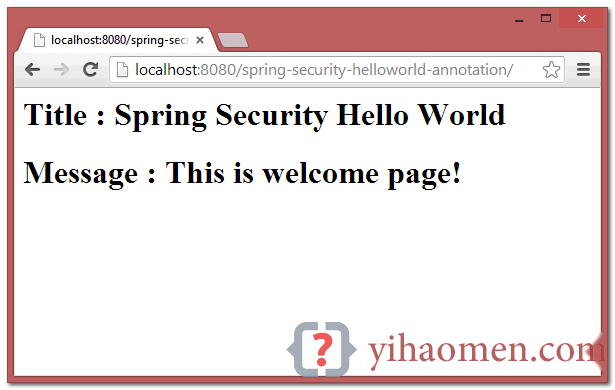
7.2 Try to access /admin page, Spring Security will intercept the request and redirect to /login, and a default login form is displayed.
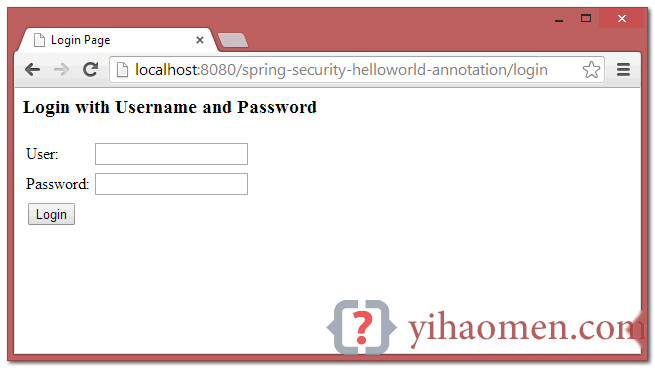
7.3. If username and password is incorrect, error messages will be displayed, and Spring will redirect to this URL /login?error.
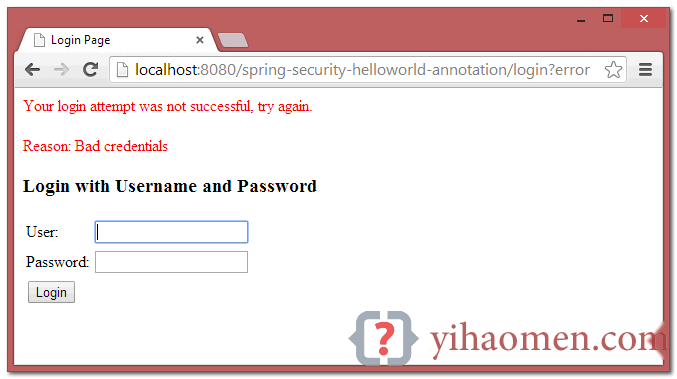
7.4. If username and password is correct, Spring will redirect the request to the original requested URL and display the page.
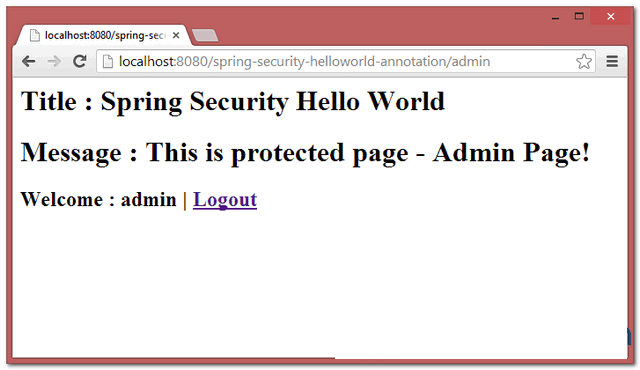
7.5. For unauthorized user, Spring will display the 403 access denied page. For example, user “mkyong” or “dba” try to access the /admin URL.
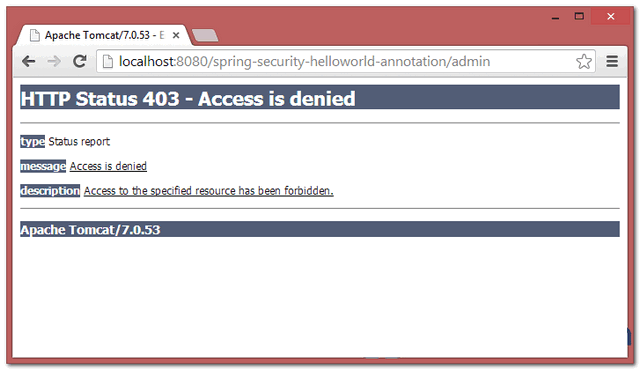
References
From:一号门

COMMENTS